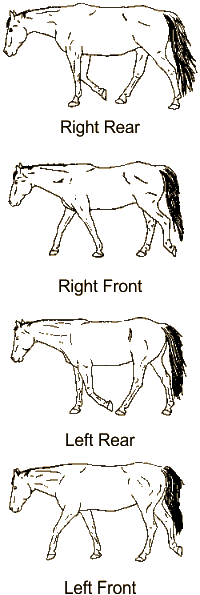Horse's Walk Movement

The walk is a four–beat gait. It begins with the horse stepping forward with his right rear foot. This is followed by the right front. The left rear is next, followed by the left front. It may appear that the gait begins with the front foot because this foot rises first. The hind foot, however, provides the push that allows this to happen. The walk is a very stable gait with three feet usually on the ground at any one time.
As a horse walks, its belly swings back and forth as the horse makes room for its alternate hind feet to step forward. The horse's pelvis may also rotate laterally.
The horse's head moves while it is walking. This movement may serve two purposes. One is balance. Therefore, the rider should allow this movement by having his hands follow his horse's head rather than the head being held rigidly in place by the rider's hands. The movement of the horse's head may be forward and back, side to side, up and down, or — more likely — a combination of these.
The second purpose for a horse moving its head is to aid its muscles in lifting its front feet and legs. This is especially true when the horse is moving with impulsion.
One should always begin a riding session by walking his horse. This allows the horse to loosen up his joints and muscles before the more strenuous work begins. Walking the horse at the end of a session allows the horse to cool down slowly, reducing the heart rate while using the motion to help pump blood to the horse's muscles bringing them oxygen and carrying away waste. The rider should not be lazy while doing this. He should use this time to attune his body to the movements of his horse.